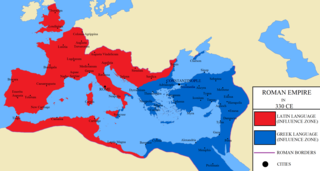| Vulgar Latin | |
|---|---|
| sermo vulgaris | |
| Era | Developed into various Romance languages by the 9th century |
Indo-European
| |
Early forms | |
| Latin | |
| Language codes | |
| ISO 639-3 | – |
lat-vul | |
| Glottolog | vulg1234 |
 Latin-speaking or otherwise heavily Latin-influenced areas in the Later Roman Empire, highlighted in red. | |
Vulgar Latin, also known as Popular or Colloquial Latin, is the range of non-formal registers of Latin spoken from the Late Roman Republic onward.[1] Vulgar Latin as a term is both controversial and imprecise. Spoken Latin existed for a long time and in many places. Scholars have differed in opinion as to the extent of the differences, and whether Vulgar Latin was in some sense a different language. This was developed as a theory in the nineteenth century by Raynouard. At its extreme, the theory suggested that the written register formed an elite language distinct from common speech, but this is now rejected.[2]
The current consensus is that the written and spoken languages formed a continuity much as they do in modern languages, with speech tending to evolve faster than the written language, and the written, formalised language exerting pressure back on speech.[3] Vulgar Latin is itself often viewed as vague and unhelpful, and it is used in very different ways by different scholars, applying it to mean spoken Latin of differing types, or from different social classes and time periods.[4] Nevertheless, interest in the shifts in the spoken forms remains very important to understand the transition from Latin or Late Latin through to Proto-Romance and Romance languages. To make matters more complicated, evidence for spoken forms can be found only through examination of written Classical Latin, Late Latin, or early Romance, depending on the time period.
- ^ Herman 2000, p. 7
- ^ Herman 2000, p. 5 "Comparative scholars, especially in the nineteenth century … tended to see Vulgar Latin and literary Latin as two very different kinds of language, or even two different languages altogether … but [this] is now out of date"
- ^ Herman 2000, pp. 5–7
- ^ Lloyd 1979, p. 120